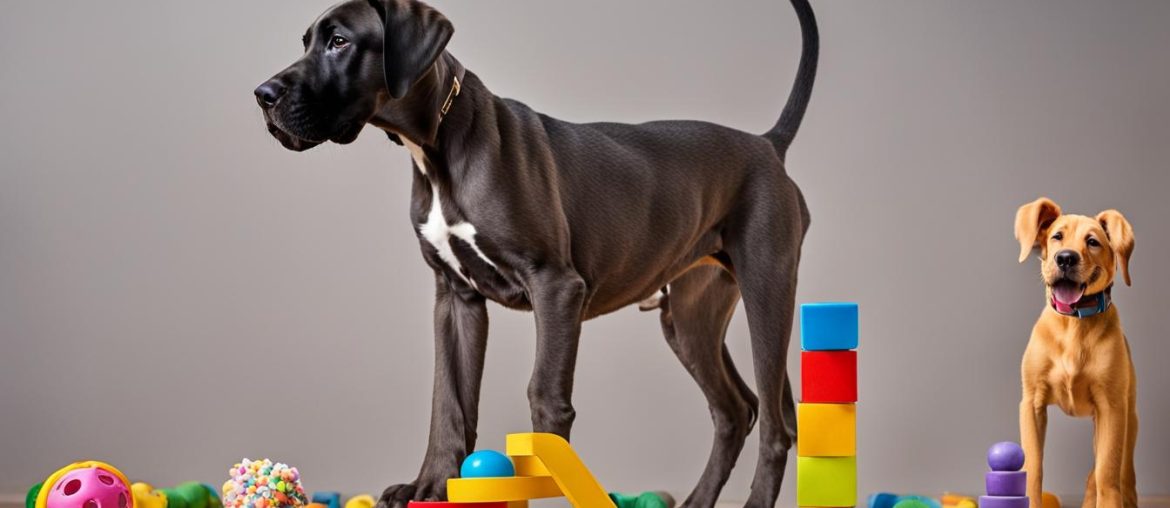As a proud owner of a Great Dane, you may be curious about when these majestic dogs reach their full size and what factors can affect their growth. In this article, I will provide you with valuable insights into the growth stages of Great Danes, the average size of adult Great Danes, and the factors that can influence their growth. Let’s dive in!
Key Takeaways:
- Great Danes typically stop growing around 18-24 months.
- The average size of adult Great Danes is 30-36 inches in height for males and 28-32 inches for females.
- Factors such as genetics, nutrition, and exercise can affect Great Dane growth.
- It’s important to monitor their growth, behavior, and overall health to ensure they are growing properly.
- Consulting with a veterinarian can provide personalized guidance throughout their growth journey.
Height Growth Schedule for a Great Dane
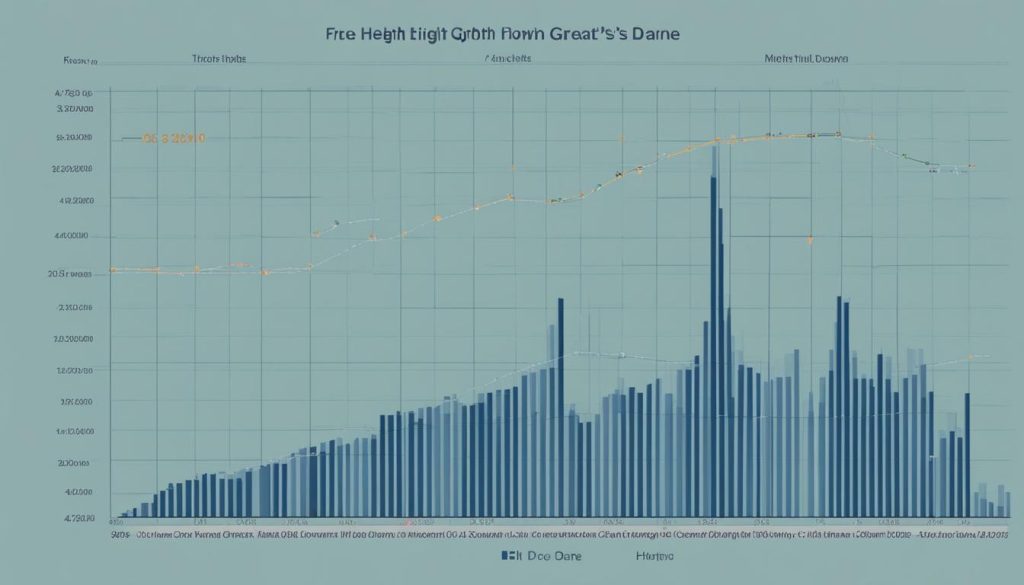
Tracking the height growth of Great Danes is essential for understanding their development. By using a height chart, we can monitor their progression and determine when they reach their full height. From the age of 2 months to 1 year, Great Danes experience gradual growth in height, with smaller shifts as they mature.
At 2 months, most Great Danes measure between 13-18 inches in height. This increases steadily over time, and by the age of 1 year, they can reach an impressive height range of 29-36 inches. It’s important to note that individual Great Danes may vary slightly from this height schedule, as each dog is unique and may not fall precisely within these guidelines.
To illustrate the growth journey of a Great Dane’s height, here is a visual representation of a typical height growth chart. This chart serves as a valuable reference to track your Great Dane’s growth progress and compare it with the expected ranges.
| Age (months) | Approximate Height (inches) |
|---|---|
| 2 | 13-18 |
| 3 | 16-22 |
| 4 | 19-25 |
| 5 | 22-28 |
| 6 | 24-30 |
| 7 | 26-32 |
| 8 | 27-34 |
| 9 | 28-35 |
| 10 | 29-36 |
| 11 | 29-36 |
| 12 | 29-36 |
Remember, this height growth chart provides a general guideline for the growth stages of Great Danes. It can be used as a helpful tool to monitor your dog’s progress and ensure they are developing within the expected range. However, it’s always important to consider individual variations and consult with your veterinarian for personalized guidance regarding your Great Dane’s growth and development.
How Height is Measured in a Great Dane
When it comes to measuring the height of a Great Dane, accuracy is key. Many people mistakenly believe that measuring from the bottom of their paws to the tips of their ears is the correct method, but this is a common misconception. The proper way to measure a Great Dane’s height is from the bottom of their paws to their withers, which is the highest point on the dog’s shoulder blades.
At dog shows, wickets or aluminum measure sticks are used to ensure precise and consistent height measurements. These tools are designed to accurately measure the Great Dane’s height from the withers to the ground.
If you want to measure your Great Dane’s height at home, you can use a carpenter’s level and a measuring tape. Place the level from the bottom of your Great Dane’s paw to the highest point on their shoulder blades, ensuring that the level is parallel to the ground. Then, use a measuring tape to measure the distance between the bottom of the paw and the top of the level. This will give you an accurate measurement of your Great Dane’s height.
Measuring your Great Dane’s height correctly is important for various reasons. It can help you determine if your Great Dane falls within the breed standard for height, which is important for show dogs. It also allows you to track your Great Dane’s growth and ensure they are developing as expected.
By following the proper method of measuring a Great Dane’s height and using the right tools, you can ensure accuracy and consistency in your measurements. This will provide valuable information about your Great Dane’s growth and help you monitor their progress over time.
Weight Growth Schedule for a Great Dane
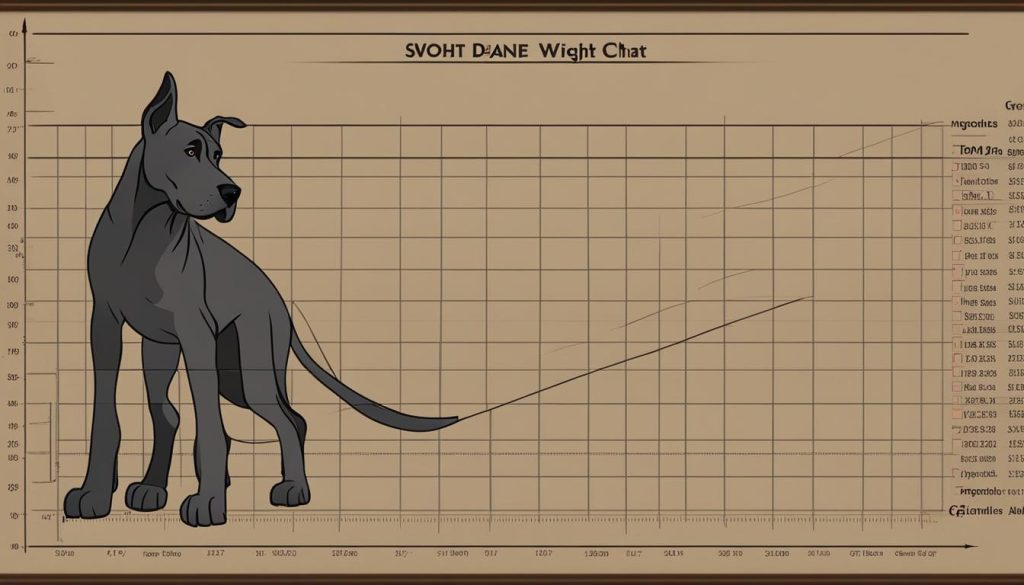
Great Dane puppies experience a rapid weight gain during their initial months of growth. It is important to monitor their weight and consult with a veterinarian to ensure healthy development. Here is a general weight growth schedule for Great Dane puppies:
| Age | Male Weight Range (in pounds) | Female Weight Range (in pounds) |
|---|---|---|
| Birth | — | — |
| 8 weeks | 25-40 | 20-35 |
| 3 months | 55-95 | 45-85 |
| 6 months | 75-120 | 60-100 |
| 9 months | 85-135 | 70-115 |
| 1 year | 95-140 | 90-120 |
Please note that these weight ranges are approximate and may vary for individual Great Danes. Regular check-ups and discussions with your veterinarian will help ensure that your Great Dane is growing at a healthy rate.
Understanding What Affects Dane Growth

Several factors can influence the growth of Great Danes. These factors include genetics, nutrition, and exercise. Let’s delve deeper into each of these factors:
Genetics and Great Dane Growth
Genetics play a significant role in determining the growth rate and potential size of Great Danes. The genes inherited from their parents can impact how tall and heavy they will ultimately become. While genetics provide a foundation for growth, it’s important to note that individual variations can still occur within the breed.
Nutrition and Great Dane Growth
Nutrition is a critical component of healthy growth in Great Danes. Providing a balanced diet with the right amount of nutrients is essential for their overall development. Keep in mind that their dietary needs can vary depending on their age, activity level, and specific health considerations. Consulting with a veterinarian can help ensure that your Great Dane is receiving the appropriate nutrition for optimal growth.
Exercise and Great Dane Growth
Regular exercise is vital for supporting muscle development and overall well-being in Great Danes. Engaging in physical activity helps them burn off excess energy and maintain a healthy weight. Moderate exercise, such as daily walks or interactive playtime, can contribute to proper growth and prevent muscle and joint problems. However, it’s essential to avoid excessive exercise during the critical growth stages, as it can potentially impact their bone development. Consulting with your veterinarian will help you determine the appropriate exercise routine for your Great Dane.
By understanding and addressing these factors, you can optimize the growth and development of your Great Dane. Monitoring their growth, behavior, and activity patterns can help identify any potential issues that may be affecting their growth.
Great Dane Feeding Schedules
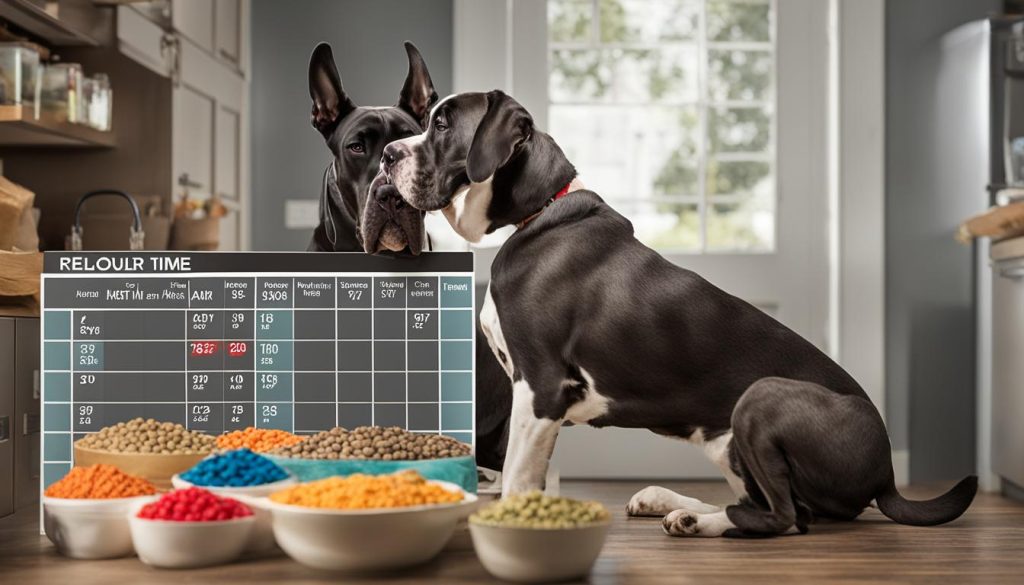
During the growth phase, it is important to establish a feeding schedule for your Great Dane to ensure proper nutrition and healthy development. As these majestic dogs have specific dietary needs, understanding how much to feed Great Dane puppies at different stages is crucial for their growth.
At 2 months of age, Great Dane puppies typically require 2-4 cups of high-quality puppy food per day, divided into three meals. This ensures they receive the necessary nutrients for their growth. As they grow older, the amount of food they need may increase.
Consulting with a veterinarian is highly recommended to determine the appropriate nutrient intake for your Great Dane. They can provide guidance on the optimal daily calorie intake, protein, fats, and fiber requirements. Additionally, your veterinarian can advise on whether any supplements are necessary to support their growth and development.
Proper nutrition is vital for the growth of Great Dane puppies. Providing a balanced diet that meets their specific nutritional needs will support their bone development, muscle growth, and overall health. It is essential to choose a high-quality puppy food formulated for large breed puppies to ensure they receive the right balance of nutrients.
Remember to monitor their weight and body condition regularly. Adjust their feeding schedule and portion sizes accordingly to maintain a healthy weight. Overfeeding can lead to excessive weight gain, which can put strain on their joints and increase the risk of skeletal issues.
Ensuring your Great Dane has a consistent feeding schedule that aligns with their growth stages and nutritional requirements is crucial for their overall well-being. By providing them with the right amount of food and nutrients, you can support their healthy growth and development.
Great Dane Growth Should be Rapid, but Steady

When it comes to Great Dane growth, a combination of rapid yet steady growth is ideal. These majestic dogs may experience growth spurts at different times, leading to temporary changes in their size and weight. However, it is important to ensure that their growth follows a consistent pattern within the expected range.
If you notice any significant deviations from the anticipated growth trajectory, it is crucial to consult with a veterinarian. They can help determine if there are any underlying health issues that may be affecting your Great Dane’s growth. Timely intervention and appropriate care can ensure that they continue to grow in a healthy and balanced manner.
Note: Great Dane growth should be carefully monitored throughout their development to ensure proper and healthy growth.
Understanding the Growth Stages of Dogs
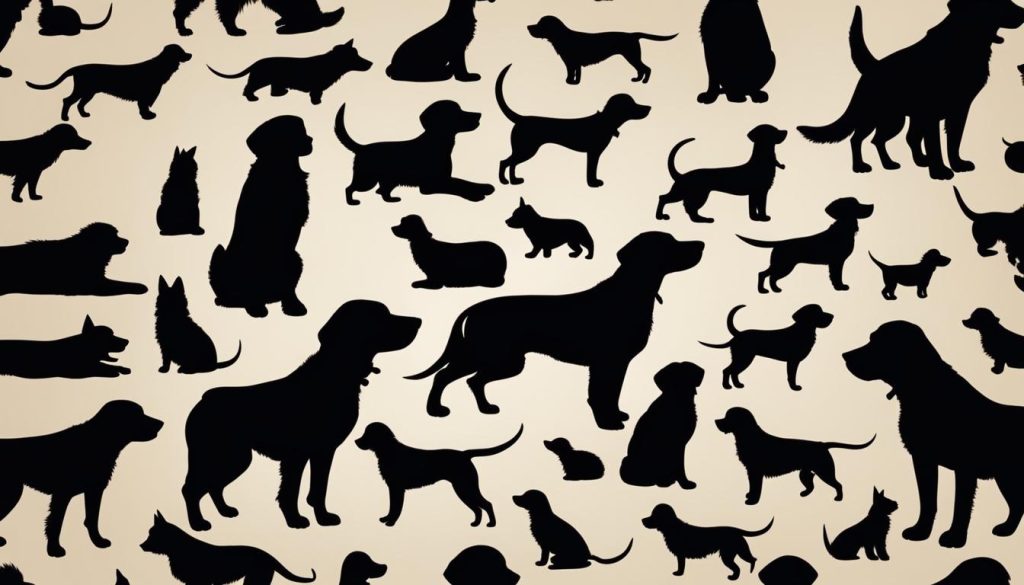
Dogs go through distinct growth stages, beginning with the neonatal stage, which lasts from birth to around two weeks old, followed by puppyhood, characterized by rapid growth and development. During the neonatal stage, puppies rely on their mother for nourishment and warmth, while their senses and motor skills begin to develop.
Once they enter puppyhood, dogs experience significant growth and physical changes. This stage is crucial for their overall development, including the formation of bones, muscles, and organs. Puppies require appropriate nutrition and care during this phase to support their growing bodies.
The duration of the growth stages varies depending on the breed and size of the dog. Small breed dogs typically stop growing around 9-12 months, while medium breed dogs continue to grow until approximately 12-16 months. Large breed dogs, including Great Danes, reach their full size around 18-24 months, while giant breed dogs may continue growing until 24-36 months.
Several factors influence a dog’s growth rate, including their breed, genetics, nutrition, and exercise regimen. Genetics play a significant role in determining a dog’s growth potential, while proper nutrition ensures they receive the necessary nutrients for healthy development. Regular exercise helps promote muscular strength and overall wellness.
By understanding the growth stages of dogs and providing appropriate care, owners can support their pet’s growth and ensure they reach their full potential.
Factors Affecting the Growth of Dogs
When it comes to the growth of dogs, several factors come into play, including breed, genetics, nutrition, and exercise. These factors play a significant role in determining the overall growth and development of a dog throughout its life.
Different breeds have different growth rates and reach their full size at different ages. For example, smaller breeds tend to reach their full size earlier, while larger breeds take longer to reach their maximum growth potential. This is why it’s important to understand the specific needs of your dog’s breed when it comes to their growth and development.
Genetics also play a crucial role in a dog’s growth. Certain genes can determine the size, height, weight, and overall structure of a dog. While genetics can provide some guidelines, it’s important to remember that there can be variations among individuals even within the same breed.
Nutrition is another key factor that influences a dog’s growth. Providing a balanced diet with the right amount of nutrients is essential for healthy growth. Puppies, in particular, require a diet that supports their rapid growth and development. Consultation with a veterinarian can help determine the appropriate diet and nutrient intake for your dog’s specific needs.
Exercise is also critical for a dog’s growth and overall well-being. Regular physical activity helps support muscle development, bone strength, and a healthy weight. However, it’s important to strike a balance and provide the right amount and type of exercise based on your dog’s age, breed, and overall health.
Consulting with a veterinarian who specializes in canine health can provide valuable guidance and support in understanding the specific factors that influence the growth of your dog. They can offer personalized advice based on your dog’s breed, size, and individual needs, ensuring that they grow and develop in a healthy and optimal manner.
Overall, understanding the factors that affect a dog’s growth is essential in providing them with proper care, diet, and exercise to support their development. By considering breed, genetics, nutrition, and exercise, you can ensure that your dog grows into a healthy, happy, and well-rounded companion.
Wrapping Up
After exploring the growth journey of Great Danes, we can conclude that these majestic dogs typically stop growing around 18-24 months, with most reaching their full height by 18 months. It is important to note that their growth should be rapid but steady, with gradual increases in both height and weight.
Factors such as genetics, nutrition, and exercise play crucial roles in the growth and development of Great Danes. Genetics determine their growth rate and potential size, while a balanced diet and the right nutrients are essential for healthy growth. Regular exercise supports muscle development and overall well-being. Monitoring their growth, behavior, and overall health is crucial to ensuring they are growing properly.
Consulting with a veterinarian throughout their growth journey can provide personalized guidance and support. Veterinarians can offer expert advice on proper nutrition, exercise routines, and monitoring growth milestones. By staying proactive and attentive to their growth needs, we can help Great Danes grow into healthy, happy adults.
FAQ
When do Great Danes stop growing?
Great Danes typically stop growing around 18-24 months. Most will reach their full height by 18 months, but continue adding muscle weight through their second year.
What is the average size of adult Great Danes?
The average size of adult Great Danes is around 30-36 inches in height for males and 28-32 inches for females. Their weight ranges from 140-175 pounds for males and 110-140 pounds for females.
How does height growth in Great Danes progress?
Height growth in Great Danes can be tracked using a height chart. From 2 months to 1 year old, their height increases gradually, with the potential for smaller shifts in height as they reach maturity.
How do you measure a Great Dane’s height accurately?
The proper way to measure a Great Dane’s height is from the bottom of their paws to their withers, which is the highest point on the dog’s shoulder blades. Measuring from the bottom of their paws to the tips of their ears is a common misconception.
What is the weight growth schedule for Great Danes?
Great Dane puppies have a rapid weight gain during their first few months of growth. From birth to 1 year old, their weight can range from 95-140 pounds for males and 90-120 pounds for females.
What factors affect the growth of Great Danes?
Several factors affect the growth of Great Danes, including genetics, nutrition, and exercise.
What is the feeding schedule for Great Danes?
During the growth phase, it is important to have a feeding schedule for Great Danes. The amount of food they should be consuming each day varies based on their age.
How should Great Dane growth progress?
Great Dane growth should be rapid but steady. They may experience growth spurts at different times, which can result in temporary changes in their size and weight.
When do dogs stop growing?
Dogs go through distinct growth stages, starting from the neonatal stage, which lasts from birth to around two weeks old, to puppyhood, which is characterized by rapid growth and development. Different breeds stop growing at different ages.
What factors influence the growth of dogs?
Several factors influence the growth of dogs, including breed, genetics, nutrition, and exercise.


